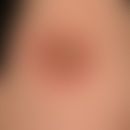Synonym(s)
After itching; anal itching; ani pruritus; anogential pruritus (e)
DefinitionThis section has been translated automatically.
Polyaetiogical symptom of the anal region.
EtiopathogenesisThis section has been translated automatically.
The most frequent causes are toxic or allergic perianal eczema, anal eczema as well as perianal localised psoriasis (here also occurring in isolation) or atopic eczema. Other causes include irritation caused by dyspeptic stools, obesity (sweating), ectoparasitosis or poor anal hygiene. Diabetes mellitus, long-term external or internal application of corticosteroids or antibiotics can lead to intestinal candidiasis and secondary to perianal itching. Pruritus ani can also be caused by relative sphincter incontinence, maceration processes as a result of mariscas, proctitis, abscesses, fistulas or condylomata acuminata. Oxyuriasis is etiologically significant, especially in infants and children, but also increasingly in older adults, with pruritus typically occurring at night. Less frequent is an infestation of the perianal region by the scabies mite. Psychogenic pruritus is not entirely uncommon (mostly exclusion diagnosis in the absence of a recognisable cause).
You might also be interested in
Clinical featuresThis section has been translated automatically.
Different clinical aspects depending on the etiology. Mostly, sharp or blurred, reddened, thickened, lichenified, also macerated (then mostly sweetish foetus) perianal skin with erosions or small-focus ulcers; also rhagade formations.
DiagnosisThis section has been translated automatically.
Targeted clarification of the cause with careful examination of the skin and mucous membrane status. In addition, depending on the clinic: mycology, prick and epicutaneous testing, excision, bacteriology, imitation preparation on oxyur eggs. In case of ambiguous assignment of the symptom, clarification by proctoscopy, rectosigmoidoscopy and, if necessary, colonoscopy for the clarification of a tumor.
TherapyThis section has been translated automatically.
Treatment of the underlying disease (see above), treatment of eczema; see under eczema, anal eczema; if necessary psychotherapeutic care.
LiteratureThis section has been translated automatically.
- Wieshuber C et al (2011) Oxyuren: Cause of pruritus ani also in elderly people? Abstract CD 46th DDG meeting:P15/25.
Outgoing links (7)
Acuminate condyloma; Anal dermatitis (overview); Fistula; Marisks; Oxyuriasis; Proctitis; Psychotherapy;Disclaimer
Please ask your physician for a reliable diagnosis. This website is only meant as a reference.




